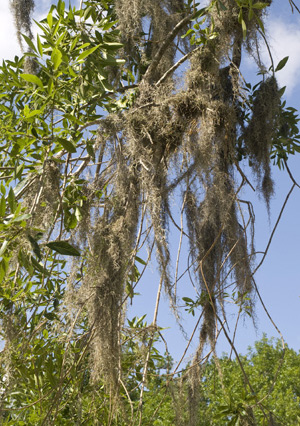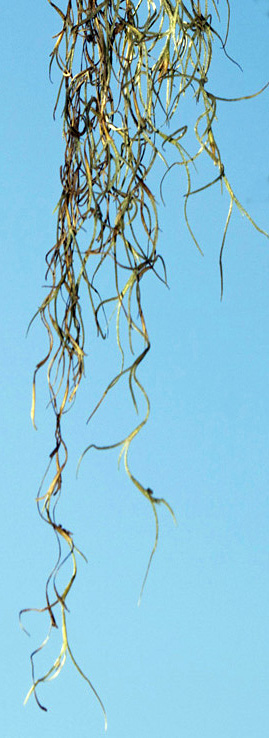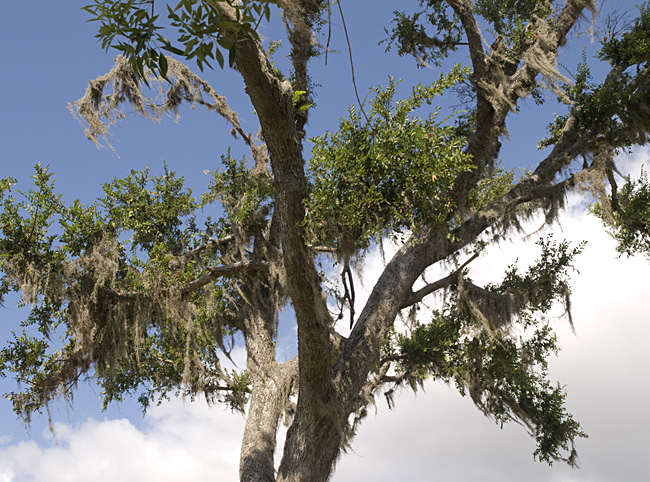Spanish Moss

Today, a remarkable stuffing. The University of Houston's College of Engineering presents this series about the machines that make our civilization run, and the people whose ingenuity created them.
So, how shall we stuff a mattress? We might use cotton or goose feathers, I suppose, but one really good material is a surprise. It's Spanish moss. Here in this large industrial Gulf Coast city, we see a lot of it. We might well conclude that it's no more than a parasitic pest on our trees. But it's not at all.
A parasite takes its nutrients from the host. But Spanish moss is neither a moss nor a parasite. It is an independent plant that takes water and nutrients from the air, not the tree. It stores water and it's very hardy. It can weigh down a branch or block light from tree leaves below. But it normally coexists harmlessly with its tree. Its thin tendrils are maybe a millimeter in diameter. They have a scaly outer hide that protects water-bearing fibers within. If it suffers a long enough drought, the interior fibers dry out and go dormant, but they don't easily die.

 Birds and breezes spread its small fragments, which then take root on neighboring trees. I picked a low-hanging clump of Spanish moss from a scrub oak over on the bayou last month -- took it home, rinsed it out, and put it on the shelf. There it sits, looking no different than it did when it hung from its tree. It seems downright indestructible.
Birds and breezes spread its small fragments, which then take root on neighboring trees. I picked a low-hanging clump of Spanish moss from a scrub oak over on the bayou last month -- took it home, rinsed it out, and put it on the shelf. There it sits, looking no different than it did when it hung from its tree. It seems downright indestructible.
When 17th-century Spanish settlers arrived, they found native women wearing clothing woven from Spanish moss. And they soon found that it was good for much more. It made an excellent binder for bricks and clay -- great to combine with mud caulking in a log cabin. It made handy kindling to start fires.
And, as we became an industrial nation, one application went commercial. That was upholstery. Settlers and natives alike had used it to stuff pillows and mattresses. Then we began curing and ginning it to eliminate the scaly outer husk of the fibers. We created an especially fine and durable stuffing.
By the early 19th century we were exporting it to England. It became a major industry. The early 20th century found Henry Ford upholstering his Model-T with Spanish moss. Later car makers kept using it. In 1927, Louisiana alone sold 1200 carloads of Spanish moss -- worth around fifty million of today's dollars.
That trade has ebbed today. It lingers in the arts and crafts world while most of its use has been replaced with cheaper Mexican sisal. Besides, it's now less available than in the past. I said it was sturdy, but it is vulnerable to certain air pollutants.
So its presence dwindles, and its use in upholstery fades. Yet one thing lingers. Movies and literature continue to show us Spanish moss as the iconic essence of an imagined south -- a cloying and ingrown world. The world that Faulkner called "Graciousness founded on hopeless wrong." But the Spanish moss that I now see is an element of commerce -- a natural resource, a product that might be used yet again in this vibrant and energetic economy.
I'm John Lienhard at the University of Houston, where we're interested in the way inventive minds work.
See Wikipedia. All photos by J. Lienhard. My thanks to Lewis Wheeler, UH Mech. Engr. Dept., for suggesting the topic.
